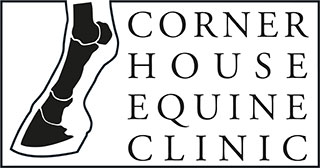We see hundreds of lame horses at the clinic every year and can offer scanning and X-raying after diagnostic nerve blocking.
We use our manege to assess horses who are subtly lame and often see these ridden.
Rob Walsh MRCVS has a further qualification in the investigation of poor performance so we accept referrals of these cases.
Diagnosis
Initially, all that is required is a thorough clinical examination. Much information can be gained by examining the horse at rest and observing the horse as he/she moves. Our vets have the experience and patience to notice subtle abnormalities in anatomy, gait or posture and only resort to further diagnostics when truly necessary. Observing on different surfaces, lunging and flexion tests are all very helpful.
In some cases, ‘nerve-blocking’ is required to confirm a diagnosis. Local anaesthetic infiltration is used to numb a region of the leg temporarily and if an improvement in the degree of lameness is seen, the site of pain is either confirmed or ruled out. All of our vets frequently attend training courses at the UK’s top referral centres to refine their skills and update their knowledge with the latest research.
Once the source of lameness is confirmed, further assessment is sometimes undertaken with radiography or ultrasonography. Although many horses will come to the clinic for a lameness work-up we also offer examinations at your premises. Our mobile equipment allows us to obtain images of an excellent quality in the comfort of your horse’s stable. We have recently invested in a wireless X-ray system, allowing us to obtain images more quickly and safely. This system can also be invaluable in an emergency situation in the field – as mains power is not required for our X-ray unit. We also have 2 high frequency ultrasound machines, particularly useful for assessing in detail any damage to soft tissues such as tendons or ligaments.
In some cases, specialist diagnostic techniques such as scintigraphy (‘bone scanning’) or MRI are needed to help with diagnosis. We have an excellent working relationship with some of the top referral hospitals in the UK where your horse can be sent. Referrals are usually accepted very quickly, often within 2 weeks of request.
Treatment
Once a diagnosis has been reached, your vet will outline treatment options, explaining the rationale behind each one and allowing you to make an informed decision. Some cases simply require a period of rest, followed by a tailored rehabilitation programme, whilst others also benefit from medical or surgical intervention. Recent advances in veterinary medicine have increased the availability of regenerative medicine in the equine world. We have seen encouraging results from regenerative therapy, in particular the use of platelet rich plasma for the resolution of soft tissue lesions. We also frequently use more conventional therapies, such as intra-articular cortisone medication and bisphosphonate infusions (commonly known as Tildren™ or Equidronate™). For more information on specific therapies, please see our information sheet entitled “Treatment Options for Lameness Cases”. In addition we have a highly portable ‘shockwave’ machine. Shockwave therapy can be used to increase the healing of damaged tissues, and is most commonly used in suspensory ligament desmitis, splints and sore backs.
Almost all aspects of treatment can be completed at your yard. For those horses requiring specialist surgery, we can refer you to the best surgeon for the specific problem involved.
Aside from the veterinary care of your horse, we appreciate the importance of good farriery, dentistry, saddlery and physiotherapy. Our vets are keen to work in conjunction with professionals in these fields in order to ensure your horse’s comfort and optimise their athletic performance.


